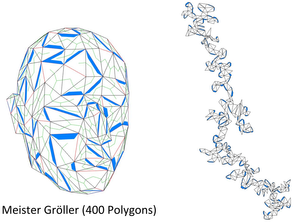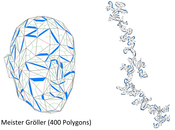Information
- Publication Type: Bachelor Thesis
- Workgroup(s)/Project(s):
- Date: September 2019
- Date (Start): 22. March 2019
- Date (End): 27. September 2019
- Matrikelnummer: 01529243
- First Supervisor: Hsiang-Yun Wu
- Keywords: mesh unfolding
Abstract
3D Mesh Unfolding is the process of transforming a 3D mesh into a 2D planar patch. This technique can be used to create papercraft models, where 3D objects get reconstructed from planar paper or paper-like material. As the reconstruction of unfolded models can be very hard, users need indicators of which faces have to be glued together. In this thesis, Gluetags are introduced to give users extra space to apply glue to ease the reconstruction. The addition of these Gluetags increases the difficulty of finding overlap-free unfoldings that can be cut out of a single piece of paper to reconstruct the model. The amount of possible unfoldings increases while the solution space shrinks when Gluetags are added. A minimum spanning tree approach is used to compute possible unfoldings, whereas simulated annealing is used to find an unfolding with no overlaps. Quantitative experiments suggest that the proposed method can yield fast results for smaller meshes. Results for larger meshes are achievable within an increased timeframe, but they also show time limitations for this approach.Additional Files and Images
Weblinks
No further information available.BibTeX
@bachelorsthesis{korpitsch_thorsten-2019,
title = "Optimising 3D Mesh Unfoldings with Additional Gluetags using
Simulated Annealing",
author = "Thorsten Korpitsch",
year = "2019",
abstract = "3D Mesh Unfolding is the process of transforming a 3D mesh
into a 2D planar patch. This technique can be used to create
papercraft models, where 3D objects get reconstructed from
planar paper or paper-like material. As the reconstruction
of unfolded models can be very hard, users need indicators
of which faces have to be glued together. In this thesis,
Gluetags are introduced to give users extra space to apply
glue to ease the reconstruction. The addition of these
Gluetags increases the difficulty of finding overlap-free
unfoldings that can be cut out of a single piece of paper to
reconstruct the model. The amount of possible unfoldings
increases while the solution space shrinks when Gluetags are
added. A minimum spanning tree approach is used to compute
possible unfoldings, whereas simulated annealing is used to
find an unfolding with no overlaps. Quantitative experiments
suggest that the proposed method can yield fast results for
smaller meshes. Results for larger meshes are achievable
within an increased timeframe, but they also show time
limitations for this approach.",
month = sep,
address = "Favoritenstrasse 9-11/E193-02, A-1040 Vienna, Austria",
school = "Research Unit of Computer Graphics, Institute of Visual
Computing and Human-Centered Technology, Faculty of
Informatics, TU Wien ",
keywords = "mesh unfolding",
URL = "https://www.cg.tuwien.ac.at/research/publications/2019/korpitsch_thorsten-2019/",
}

 image
image

